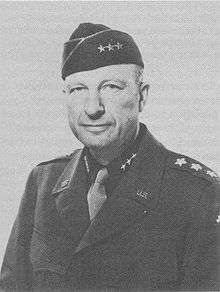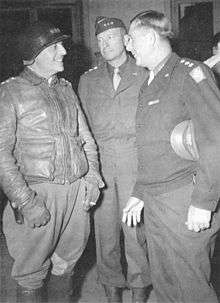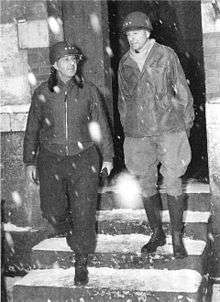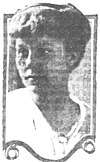Alexander Patch
Alexander McCarrell Patch (November 23, 1889 – November 21, 1945) was a senior United States Army officer who fought in both World War I and World War II, rising to rank of general. During World War II he commanded U.S. Army and U.S. Marine Corps forces during the Guadalcanal Campaign, and the U.S. Seventh Army on the Western Front.
Alexander Patch | |
|---|---|
 | |
| Birth name | Alexander McCarrell Patch |
| Nickname(s) | "Sandy" |
| Born | November 23, 1889 Fort Huachuca, Arizona, United States |
| Died | November 21, 1945 (aged 55) Fort Sam Houston, Texas, United States |
| Buried | West Point Cemetery, West Point, New York, United States |
| Allegiance | |
| Service/ | |
| Years of service | 1913–1945 |
| Rank | |
| Unit | |
| Commands held | 3rd Machine Gun Battalion 1st Battalion, 18th Infantry Regiment 47th Infantry Regiment 23rd Infantry Division XIV Corps IV Corps Seventh Army Fourth Army |
| Battles/wars | Pancho Villa Expedition World War I World War II |
| Awards | Army Distinguished Service Medal Navy Distinguished Service Medal Bronze Star |
With an invasion of Japan still an apparent likelihood, Patch returned to the U.S. in August 1945 to take charge of the Fourth Army headquartered at the Fort Sam Houston, Texas. He died in November 1945 at 55, his health having been ravaged during his time in the Pacific early in the war. Patch and Lucian K. Truscott Jr. were the only U.S. Army officers to command a division, corps and field army on active service during World War II.
A lieutenant general at the time of his passing, he was posthumously promoted to four star general in July 1954.
Early life and military career
Patch was born in Fort Huachuca, Arizona, although he was raised in Pennsylvania. His father, Captain Alexander M. Patch, was a former cavalryman in the United States Army and an 1877 graduate of the United States Military Academy (USMA) at West Point, New York and his mother was Annie Moore Patch, the daughter of Congressman William S. Moore of Pennsylvania. Of German, Scottish and Irish descent, Patch attended Lehigh University for a year, before receiving an appointment to West Point in 1909. Patch's eldest brother, Joseph Dorst Patch and commonly known as "Dorst", also enlisted in the army the same year. He originally wanted to join the Cavalry Branch, but, realizing that it was becoming obsolete, he instead chose the Infantry Branch of the U.S. Army, and was commissioned on June 12, 1913, after graduating 75th in a class of 93. Some of his classmates, all of whom were, like Patch, destined to become general officers, included William R. Schmidt, Henry B. Lewis, Henry B. Cheadle, Paul Newgarden, Charles H. Corlett, Robert L. Spragins, Douglass T. Greene, Willis D. Crittenberger, William A. McCullogh, Robert M. Perkins, Carlos Brewer, Geoffrey Keyes, Louis A. Craig, Lunsford E. Oliver, Richard U. Nicholas, Francis K. Newcomer.
Upon being commissioned, Patch's first assignment was with the 18th Infantry Regiment, then based in Texas City, Texas. He later saw action in the Pancho Villa Expedition into Mexico in 1916, and was later promoted to first lieutenant. In November that year he married Julia A. Littell, the daughter of an army general, who Patch had met while he was a cadet at West Point.
In June 1917, two months after the American entry into World War I, he was promoted to the rank of captain and was, along with his brother Dorst, sent overseas with his regiment, which became part of the 1st Infantry Division, to join the American Expeditionary Force (AEF) on the Western Front where he remained until November. He then attended the British Army's Machine Gun School in England and commanded the 3rd Machine Gun Battalion of the 1st Division until April 1918, when he then went on to direct the U.S. Army's Machine Gun School until October. Towards the end of 1918, returning to the 18th Infantry, he fought in the Second Battle of the Marne, the Battle of Saint-Mihiel and the Meuse-Argonne Offensive, the largest battle in the history of the United States Army. His leadership came to the attention of Colonel George Marshall, then a member of General John J. Pershing's staff. The war came to an end on November 11, 1918, at 11:00am, by which time Patch was a lieutenant colonel, having been promoted to the rank a month before, and major the previous January. In February 1919 he reverted to the rank of captain and was a staff officer at AEF Headquarters.
Between the wars
After briefly serving on occupation duties, Patch returned to the United States in May 1919 and chose to remain in the army during the interwar period. After four years at Fort Benning, Georgia, and Washington, D.C., he spent the next few years as professor of military science and tactics at Staunton Military Academy, Virginia. He returned to this post twice in the interwar years, from 1925–28 and 1932–36. In 1922 he attended the Field Officer's Course at the U.S. Army Infantry School at Fort Benning. In 1924 he attended the U.S. Army Command and General Staff School at Fort Leavenworth, Kansas and graduated there with distinction a year later.
This was followed by service with the 3rd Battalion, 12th Infantry Regiment from 1929–31 at Fort Washington, Maryland. He then entered the U.S. Army War College in 1931 and graduated the following year. Promoted again to lieutenant colonel, he was later a member of the Infantry Board at Fort Benning, Georgia, from 1936–39, where he helped to develop the army's transformation from the old square division, with four infantry regiments, into the triangular division, with three.
In November 1940 he was promoted to colonel and assumed command of the 47th Infantry Regiment, then part of the 9th Infantry Division commanded by Major General Jacob L. Devers. General George Marshall, who had been impressed with Patch's leadership in France in World War I, was appointed Army Chief of Staff in 1939, just before World War II. He promoted Patch to the one-star general officer rank of brigadier general in August 1941, and sent him to Fort Bragg, North Carolina, to supervise the training of new soldiers there.
World War II
Pacific Theater
Patch was promoted to major general in November 1941 and was assigned to command Task Force 6814, a hastily assembled force of divisional size, composed of two Army National Guard infantry regiments. The following month the Japanese attacked Pearl Harbor, followed shortly after by the German declaration of war on the United States, officially bringing the United States into World War II. He was sent to the Pacific Theater of Operations to organize the reinforcement and defense of New Caledonia, arriving there in March 1942. En route he was struck with pneumonia, recovering sufficiently to take command of a loose collection of units and form them into the Americal Division (a contraction of "American, New Caledonian Division").
The Americal Division first saw action in the Guadalcanal Campaign in December 1942, when it relieved the valiant but tired and malaria-ridden 1st Marine Division there. The Americal Division and the 1st Marine Division were both relieved by the 25th Infantry and 2nd Marine Divisions, respectively and, in early January 1943, Patch moved up to command of the XIV Corps, and was given charge of the entire offensive on Guadalcanal. Patch personally led troops under his command on a dangerous offensive in the Battle of Mount Austen, the Galloping Horse, and the Sea Horse to capture several fortified hills and ridges from the Japanese forces. Under Patch's leadership, by February 1943 the Japanese were driven from Guadalcanal.
The Oregon Maneuver
In the wake of Guadalcanal's conquest, the state of Patch's health, battered by his bout of pneumonia, tropical dysentery and malaria, forced George Marshall to recall him back to the U.S. There, after recovering from his illness, he took command in May 1943 of the IV Corps at Fort Lewis, Washington. That fall he commanded the 100,000 man strong Oregon Maneuver in central Oregon, the largest training exercise of World War II, designed to test United States Army units prior to deployment in support of Allied combat operations in both the European and Pacific Theaters. In early 1944 he took the corps, then just a headquarters, overseas to Algiers, Algeria to the Mediterranean Theater of Operations (MTO). By mid summer he would put his Oregon Maneuver experience to the test in Operation Dragoon, the amphibious assault of southern France that was pressed clear to the Alsace-Lorraine on Germany's southwest flank before year's end.
Mediterranean and European Theaters
In March 1944, handing over command of IV Corps to Major General Willis D. Crittenberger, a fellow 1913 West Point classmate, Patch took over command of the Seventh Army from Lieutenant General Mark W. Clark, then commanding the Fifth Army in the Italian Campaign. The Seventh Army was intended to participate in an upcoming amphibious operation in southern France, codenamed Operation Dragoon. For this operation the Seventh Army was composed of several veteran formations pulled out of the fighting in Italy, Major General Lucian Truscott's U.S. VI Corps and General Alphonse Juin's French Expeditionary Corps (CEF), along with numerous airborne units in support.

Under Patch, the Seventh Army invaded southern France in Operation Dragoon on 15 August 1944. Patch–promoted to the three-star rank of lieutenant general three days later–then led the Seventh Army in a fast offensive up the Rhône valley. On 9 September 1944, near Dijon, France, it met up with the Third Army, under Lieutenant General George S. Patton, which had driven east from Normandy. The Seventh Army came under the command of the 6th Army Group, commanded by Lieutenant General Jacob L. Devers. One of Patch's corps commanders, Major General Truscott, who commanded the VI Corps, which came under command of Patch's Seventh Army, wrote of him, "I came to regard him as a man of outstanding integrity, a courageous and competent leader, and an unselfish comrade-in-arms."

The Seventh Army distinguished itself in difficult winter conditions during the Vosges Mountains campaign, clearing strong and entrenched German forces from the west bank of the Rhine and stopping a German counteroffensive, Operation Nordwind, while reserve forces were being committed to the Battle of the Bulge. The campaign marked the only contested advance through the Vosges Mountains ever to succeed.
Patch stayed in command of the Seventh Army through the end of the war in Europe in May 1945, leading the Seventh Army in Operation Undertone through the Siegfried Line, over the Rhine, and then the Western Allied invasion of Germany into southern Germany. By war's end forward elements sprawled as far afield as Austria[1] and northern Italy.[2]
In the spring of 1945, the Supreme Allied Commander on the Western Front, General Dwight D. Eisenhower, offered Patch a B-25 Mitchell and pilot for his personal use. Patch turned down the offer because he wished to remain in touch with his subordinate commanders during fast-moving operations and preferred a smaller plane that could land on unimproved fields and pastures. Patch narrowly escaped injury or death on 18 April 1945, while flying from Kitzingen to Öhringen in Germany during the Battle of Nuremberg. His Stinson L-5 Sentinel liaison aircraft Sea Level was intercepted by a German Messerschmitt Bf 109 fighter, but the pilot, Technical Sergeant Robert Stretton, maneuvered the L-5 so skillfully that it escaped and landed safely at Öhringen. Stretton later received the Distinguished Flying Cross for the flight.[3]
In August 1945, Patch returned to the United States to take command of the Fourth Army headquartered at the Fort Sam Houston, Texas, but was soon hospitalized with lung problems and shortly passed away.

Personal life
On 20 November 1915, he married Julia Adrianne Littell (1893–1988), daughter of Brigadier General Isaac William Littell.[4] They had two children. Patch suffered personal tragedy when their son, Captain Alexander M. Patch III, was killed in action on 22 October 1944 while serving as an infantry company commander in the 315th Infantry Regiment of the 79th Infantry Division in the Meurthe-et-Moselle department in north-eastern France. Captain Patch was a posthumous recipient of the Distinguished Service Cross, the Silver Star and Purple Heart. He is interred in the Epinal American Cemetery and Memorial, Lorraine, France.
General Patch died of pneumonia on November 21, 1945, two days short of his 56th birthday, at Brooke General Hospital at Fort Sam Houston, Texas. He is buried at West Point Cemetery on the grounds of the USMA.
Legacy
Kurmärker Kaserne, in Stuttgart-Vaihingen, West Germany, was renamed Patch Barracks in his honor on July 4, 1952. Patch Barracks is the home of Headquarters, United States European Command (HQ USEUCOM), the supreme American military command in Europe. Patch Barracks also has a middle school named after General Patch. The United States Navy transport USNS General Alexander M. Patch (T-AP-122) was also named for General Patch. Boulevard Patch going from the main road to Pampelonne Plage in Ramatuelle in the Provence-Alpes-Côte d'Azur of southeastern France is named for General Patch.
Patch was promoted posthumously to full general on 19 July 1954 under Pub.L. 83–508.
Awards and decorations
Ribbon bar with the list of General Alexander M. Patch's decorations:
| 1st Row | Army Distinguished Service Medal with two Oak Leaf Clusters | Navy Distinguished Service Medal | Bronze Star Medal | Mexican Border Service Medal |
|---|---|---|---|---|
| 2nd Row | World War I Victory Medal with three battle stars | American Defense Service Medal | American Campaign Medal | Asiatic-Pacific Campaign Medal w/ two service stars |
| 3rd Row | European-African-Middle Eastern Campaign Medal w/ three service stars | World War II Victory Medal | Companion of the Order of the Bath (United Kingdom) | Commander of the Légion d'honneur (France) |
| 4th Row | Croix de guerre with palm (France) | Order of Leopold II, Grand Cross (Belgium) | Croix de guerre with palm (Belgium) | Order of Abdon Calderón (Ecuador) |
Dates of rank
| Insignia | Rank | Component | Date |
|---|---|---|---|
| No insignia | Cadet | United States Military Academy | March 1, 1909 |
| No insignia in 1913 | Second lieutenant | Regular Army | June 12, 1913 |
| First lieutenant | Regular Army | July 1, 1916 | |
| Captain | Regular Army | May 15, 1917 | |
| Major | National Army | January 5, 1918 | |
| Lieutenant colonel | National Army | October 31, 1918 | |
| Captain | Regular Army | March 15, 1920 | |
| Major | Regular Army | July 1, 1920 | |
| Lieutenant colonel | Regular Army | August 1, 1935 | |
| Colonel | Army of the United States | June 26, 1941 | |
| Brigadier general | Army of the United States | August 4, 1941 | |
| Major general | Army of the United States | March 10, 1942 | |
| Colonel | Regular Army | July 1, 1942 | |
| Lieutenant general | Army of the United States | August 7, 1944 | |
| General | Posthumous | July 19, 1954 |
Notes
- Grotjean, David, Technician Five 2 1/2 ton truck driver Oral History interview at the Library of Congress
- Wallace, Linnel, Lt. Col., Commanding Officer, Summary History of the 289th Engineer Combat Battalion – WW II, 1990, U.S. Army Heritage and Education Center, Carlisle, PA
- Weirather, pp. 18-19.
- "Patch-Littell". Evening Star. Washington, D.C. 21 November 1915. p. 4 of Part 7. Retrieved 16 May 2015.
- Official Register of Commissioned Officers of the United States Army, 1945. pg. 723.
References
- Charles Pfannes and Victor Salamone. The Great Commanders of World War II, Volume III: The Americans.
- Weirather, Larry. "Saving General Patch." Aviation History, May 2012, pp. 18–19.
- William K. Wyant (1991). Sandy Patch: A Biography of Lt. Gen. Alexander M. Patch. Praeger. ISBN 0-275-93454-3.
External links
| Wikimedia Commons has media related to Alexander M. Patch. |
- "Alexander M. Patch 1913". Memorials. West Point Association of Graduates. Archived from the original on 2016-02-24.
- Lost Victory - Strasbourg, November 1944
- Alexander Patch at Find a Grave
| Military offices | ||
|---|---|---|
| Preceded by New post |
Commanding General 23rd Infantry Division May 1942 – December 1942 |
Succeeded by Edmund Sebree |
| Preceded by New post |
Commanding General XIV Corps 1942–1943 |
Succeeded by Oscar Griswold |
| Preceded by New post |
Commanding General IV Corps 1943–1944 |
Succeeded by Willis D. Crittenberger |
| Preceded by Mark W. Clark |
Commanding General Seventh Army 1944–1945 |
Succeeded by Wade H. Haislip |
| Preceded by John P. Lucas |
Commanding General Fourth Army August 1945 – November 1945 |
Succeeded by Jonathan M. Wainwright |